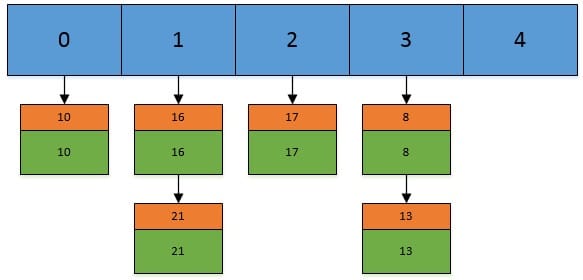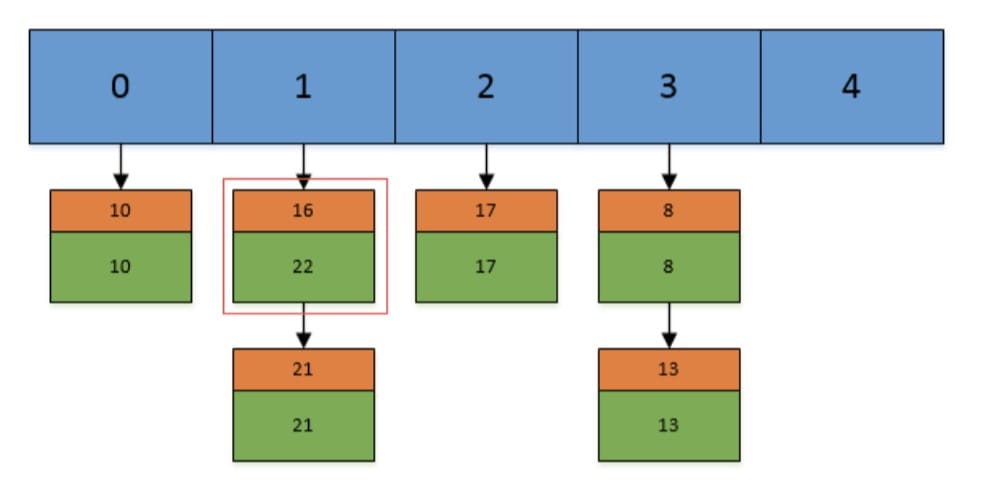一、概述
和HashMap一样,Hashtable也是一个散列表,它存储的内容是键值对。
Hashtable在Java中的定义为:
|
|
从源码中,我们可以看出,Hashtable继承于Dictionary类,实现了Map, Cloneable, java.io.Serializable接口。其中Dictionary类是任何可将键映射到相应值的类(如 Hashtable)的抽象父类,每个键和值都是对象(源码注释为:The Dictionary class is the abstract parent of any class, such as Hashtable, which maps keys to values. Every key and every value is an object.)。但其Dictionary源码注释是这样的:NOTE: This class is obsolete. New implementations should implement the Map interface, rather than extending this class. 该话指出Dictionary这个类过时了,新的实现类应该实现Map接口。
二、成员变量
Hashtable是通过”拉链法”实现的哈希表。它包括几个重要的成员变量:table, count, threshold, loadFactor, modCount。
- table是一个Entry[]数组类型,而Entry(在HashMap中有讲解过)实际上就是一个单向链表。哈希表的”key-value键值对”都是存储在Entry数组中的。
- count是Hashtable的大小,它是Hashtable保存的键值对的数量。
- threshold是Hashtable的阈值,用于判断是否需要调整Hashtable的容量。threshold的值=”容量*加载因子”。
- loadFactor就是加载因子。
- modCount是用来实现fail-fast机制的。
变量的解释在源码注释中如下:
|
|
三、构造方法
Hashtable一共提供了4个构造方法:
- public Hashtable(int initialCapacity, float loadFactor): 用指定初始容量和指定加载因子构造一个新的空哈希表。useAltHashing为boolean,其如果为真,则执行另一散列的字符串键,以减少由于弱哈希计算导致的哈希冲突的发生。
- public Hashtable(int initialCapacity):用指定初始容量和默认的加载因子 (0.75) 构造一个新的空哈希表。
- public Hashtable():默认构造函数,容量为11,加载因子为0.75。
- public Hashtable(Map<? extends K, ? extends V> t):构造一个与给定的 Map 具有相同映射关系的新哈希表。
|
|
四、put方法
put方法的整个流程为:
- 判断value是否为空,为空则抛出异常;
- 计算key的hash值,并根据hash值获得key在table数组中的位置index,如果table[index]元素不为空,则进行迭代,如果遇到相同的key,则直接替换,并返回旧value;
- 否则,我们可以将其插入到table[index]位置。
|
|
通过一个实际的例子来演示一下这个过程:
假设我们现在Hashtable的容量为5,已经存在了(5,5),(13,13),(16,16),(17,17),(21,21)这5个键值对,目前他们在Hashtable中的位置如下:
现在,我们插入一个新的键值对,put(16,22),假设key=16的索引为1.但现在索引1的位置有两个Entry了,所以程序会对链表进行迭代。迭代的过程中,发现其中有一个Entry的key和我们要插入的键值对的key相同,所以现在会做的工作就是将newValue=22替换oldValue=16,然后返回oldValue=16.
然后我们现在再插入一个,put(33,33),key=33的索引为3,并且在链表中也不存在key=33的Entry,所以将该节点插入链表的第一个位置。

五、get方法
相比较于put方法,get方法则简单很多。其过程就是首先通过hash()方法求得key的哈希值,然后根据hash值得到index索引(上述两步所用的算法与put方法都相同)。然后迭代链表,返回匹配的key的对应的value;找不到则返回null。
|
|
六、遍历方式
Hashtable有多种遍历方式:
|
|

